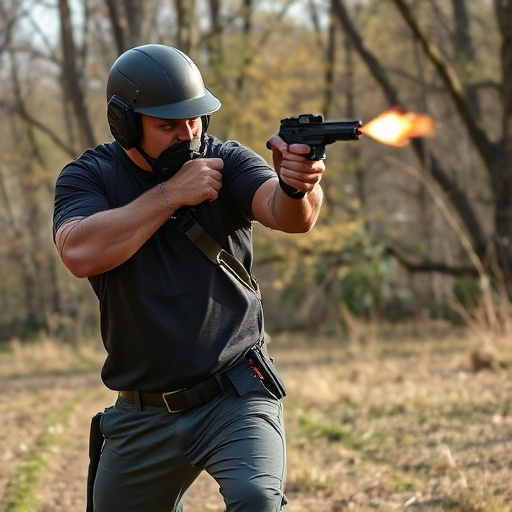Taser vs Stun Gun: Features, Maintenance, and Key Differences
This text compares Tasers and stun guns, emphasizing their differences in operation and maintenance……..
This text compares Tasers and stun guns, emphasizing their differences in operation and maintenance. While both are non-lethal personal defense tools, Tasers emit powerful single pulses from a distance, while stun guns deliver continuous low-voltage discharges through direct contact. Stun guns require regular monthly maintenance, including cleaning, battery checks, and testing charge and output, for optimal performance and safety. Tasers need less frequent upkeep, focusing on probe and trigger mechanism care due to their distinct operational mechanisms. Understanding these differences and following appropriate maintenance tips ensures the effectiveness and reliability of each device in self-defense situations.
In the realm of personal safety, Tasers and stun guns are similar yet distinct tools. Understanding their unique features is crucial for informed decisions. This comprehensive guide delves into the intricacies of each device, offering a detailed comparison to help users make choices that suit their needs. From understanding Tasers’ electric pulses to exploring stun guns’ key functions, we also provide essential maintenance tips for optimal performance, focusing on stun gun monthly care routines.
- Understanding Tasers: A Comprehensive Overview
- Unlocking Stun Guns: Key Features and Functions
- Monthly Maintenance for Optimal Performance: Stun Gun Care Tips
- Comparing Side-by-Side: Taser vs Stun Gun Differences
Understanding Tasers: A Comprehensive Overview

Tasers, officially known as Conductivity Energy Devices (CEDs), are non-lethal weapons designed to temporarily incapacitate a target through muscle paralysis. They work by delivering a strong electrical current that disrupts the target’s nerve signals, causing intense pain and muscle spasms. This disruption lasts for several seconds, enabling the user and nearby bystanders to move away from the threat safely. Regular maintenance of tasers is crucial, especially considering stun guns, another popular personal defense tool, have distinct differences.
When it comes to stun guns, monthly maintenance tips include keeping the device clean and dry, ensuring proper battery functionality, and regularly testing the stun gun’s charge and output. Unlike tasers, which fire a single powerful pulse, stun guns deliver a series of low-voltage electrical discharges over an extended period. This continuous discharge can be more effective against larger targets but may require closer proximity for optimal performance. Understanding these nuances is essential when choosing between a taser and a stun gun, each with its unique advantages and maintenance requirements.
Unlocking Stun Guns: Key Features and Functions

Stun guns, also known as electric immobilization devices, are designed to temporarily disable a target through electrical impedance. Unlocking their full potential requires understanding key features and functions that set them apart from other self-defense tools. One of the primary aspects is their power source; unlike tasers that use rechargeable batteries, stun guns often rely on non-rechargeable ones, making monthly maintenance tips crucial for optimal performance. Regular checks include ensuring proper battery functionality, cleaning the device according to manufacturer guidelines, and inspecting for any signs of damage or wear.
Moreover, stun guns vary in terms of voltage, shape, size, and output. Voltage levels play a significant role in determining the level of immobilization; higher voltages can cause more intense reactions but may require closer proximity to the target. Shape and size considerations are essential for ease of carry and accessibility in various situations. Output refers to the intensity of the electrical discharge, with some models featuring adjustable settings for different needs and scenarios. Regular maintenance not only ensures these features function optimally but also helps prolong the stun gun’s lifespan.
Monthly Maintenance for Optimal Performance: Stun Gun Care Tips

Maintaining your stun gun properly is crucial for ensuring optimal performance and reliability. Stun guns, like any other device, require regular care to function at their best. One essential aspect is monthly maintenance, which includes cleaning and battery checks. Start by wiping down the device with a soft cloth to remove any built-up dirt or debris. Be gentle around the electrical components to avoid damage. Then, inspect the batteries; replace them if they show signs of wear or corrosion. It’s recommended to use high-quality batteries specifically designed for stun guns to guarantee a consistent electric current.
Additionally, lubricate the trigger mechanism with a light oil to prevent rust and ensure smooth operation. Remember, proper storage is also vital. Keep your stun gun in a secure, dry place away from extreme temperatures and direct sunlight. These simple steps will go a long way in maintaining the device’s efficiency, ensuring you’re prepared when you need it most.
Comparing Side-by-Side: Taser vs Stun Gun Differences

When comparing Tasers and stun guns, several key differences stand out. Tasers, officially known as Conducted Electrical Weapons (CEW), fire two thin probes connected to wires that deliver a high-voltage electrical pulse to temporarily disable a target. This makes them more effective at keeping individuals immobilized over longer periods compared to stun guns, which use electric current to disrupt nerve impulses in the body, causing muscle spasms and temporary incapacitation.
Stun guns, on the other hand, require direct contact or proximity to deliver a shock, while Tasers can operate from a distance of up to 35 feet. Additionally, stun guns typically have lower voltage outputs, making them less effective for crowd control or high-risk situations. Regular stun gun monthly maintenance tips, such as keeping the device clean and ensuring proper battery levels, are crucial for optimal performance and safety. Comparatively, Tasers often demand less upkeep, with focus on probe and trigger mechanism maintenance, reflecting their distinct operational mechanisms.
In the quest for personal safety, understanding the nuances between a taser and a stun gun is paramount. While both devices serve as powerful deterrents, their operational differences and care requirements vary significantly. Tasers utilize electrical pulses to disrupt muscle control, while stun guns employ high-voltage, low-amperage electric discharge. Regular stun gun monthly maintenance tips, such as cleaning and inspection, are crucial for optimal performance and reliability. By considering these distinctions and implementing proper upkeep, individuals can make informed choices to enhance their personal security.


